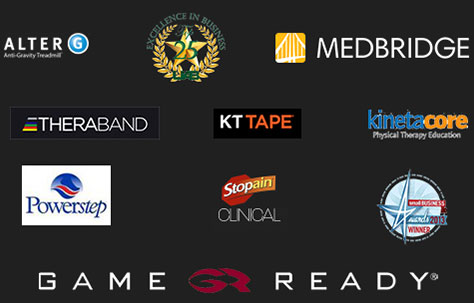Featured Therapist: Justin Kirk, PT, DPT
When the average temperature drops below 80 degrees, you will typically see more runners out and about. The cooler weather invites us to spend more time outdoors, and with mask mandates at many gyms and fitness centers, some athletes are turning to exercises they can do anywhere, like running.
Whether you’re a passionate, seasoned runner or just starting out, you’re vulnerable to the aches and pains that can slow you down, and if ignored, lead to injury.
Pain with running is common, but it doesn’t have to be!
Through proper training and an understanding of how running affects YOUR body, you can prevent running injuries and become a healthy, successful runner.
Load tolerance and Injury prevention
Running produces many favorable outcomes: better cardiovascular health, healthier weight, more muscle, better sleep, less stress, better blood sugar regulation, improved bone density, just to list a few. Most people would say they started running to obtain one, or more, of these outcomes.
Unfortunately, when some people pick up running (or start running again), their body cannot adapt quickly enough to handle the physical demands, extra impact on their bones, or the increased load on their muscles.
What does this mean? When we run, our bones, ligaments, and muscles experience forces that are greater than in our everyday lives. Depending on the person, studies show that when we run, we experience forces equal to 2-4 times our body weight. If you recover from them, these forces help drive favorable adaptations – but if you’re not used to handling that kind of load, injuries can develop.
Running is unique in that every time you run, you put a few thousand steps on your legs. To contrast, imagine starting a new workout program that begins with a few thousand squats!
So how do you avoid load tolerance issues when beginning to run? Start a gradual program to ensure that your body has enough time to recover, remodel, and adapt to the new physical stresses of running. The “couch to 5K” program has gained lots of attention for this reason. The Physical Therapists at TherapySouth have also developed a Return-To-Run program specifically designed for runners who go through rehabilitation for a running injury.

Strength training (for runners!)
One of the most common misconceptions I see in runners (speaking as a previous member of the guilty party) is that very few runners do any kind of strength training. Most would claim that “running is enough”. After all, running does make you stronger, faster, and leaner – right?
But when it comes to PREVENTING running injuries, strength training is the single most effective intervention. The research shows strength training is better at preventing injuries than stretching or selecting a shoe that matches your foot type. So if the research on strength training is significant, why aren’t more runners doing it? There are two common places that runners get hung up:

Time constraints
Running-specific goals require lots of running, and lots of running requires lots of time. This usually means runners are more likely to use their time to run instead of strength train.
Here’s where the rubber meets the road: strength training prevents time lost from running. Since running is an aerobic activity, adaptations occur quickly – but they are also lost quickly. You are only as good as you are uninjured. A running program without strength training is a misconception that often leads to weak runners and more time spent injured.

Physique constraints
Most people who run want to either obtain (or maintain) a lean, fast physique. The desire to “not get too bulky and slow” really is a misconception. Our bodies typically do not want to grow bulky muscles. Just think of the effort bodybuilders must put in!
So, unless you eat six protein meals per day, lift for an hour five to six days per week, and follow a program that specifically leads to hypertrophy… odds are you won’t get big and bulky.
Strength training is useful because it increases your muscles capacity for running (via increased tolerance to load). Strong muscles are capable of handling strong loads. For example, imagine if you hold a thick rubber band in one hand and a thin rubber band in your other. Which band do you think can withstand more load? For more information on benefits of strength training for runners, check out the articles here and here.

Get your running form assessed
Running evaluations are insightful because they reveal what you can’t see. Usually when running, you’re not in a place where you can see your own body move. I distinctly remember performing a run eval with a runner who had recently completed a half marathon, and as we were watching the video I took of her running, she said, “Oh my gosh, I run like that!?” After looking at the biomechanics of her run, it was no surprise why her MCL was sprained!
Running evaluations are fantastic for identifying biomechanical weak links, compensations in your form, or flexibility restrictions that are predisposing you for injury. If you have a running injury in your recent history, this assessment can give you extra confidence that when you return to running, your technique is “clear” from deficits, restrictions, and weak links!

The return-to-run process is when you most need a physical therapist that understands the nuances of running. Consider this like earning your “runners permit”.
TherapySouth offers many services and treatments specific to runners, as well as a wealth of knowledge on how to improve your form and function to be a better, healthier athlete. Our physical therapists can work with you to address any limitations that may be holding you back.
Justin Kirk, PT, DPT has a Bachelor’s in Exercise Science and a Doctorate of Physical Therapy from The University of Alabama – Birmingham. Justin has a background in running, strength training, and teaching human anatomy. He currently works at TherapySouth’s Lakeview clinic.
Justin is passionate about treating athletes of all levels, and especially loves working with UAB’s athletes, alongside their athletic trainers. He writes and publishes content on injury prevention, running, and athletics on Instagram @theliftingPT.







